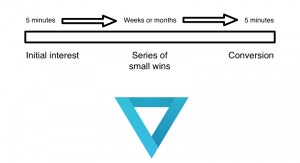Web 3 hopes to bring together many existing, cutting-edge technologies, but it is still long on concepts and short on implementation.
Web 1.0 was just information listed on a web page.
Web 2.0 made the web page interactive.
Web 3.0 runs on blockchain, enables the use of crypto-currencies and NFTs, and uses AI.
Say that again?
Bringing many existing, but cutting-edge technologies together, Web3 is supposed to be “the next big thing”, taking the internet into the 21st century. But like any new technology, Web3 is long on concepts and short on implementation. People are still trying to figure out how to use this.
It beta be good
Major brands are giving the technology a test drive. Last November, Nike announced the creation of .SWOOSH, a Web3 platform now in beta testing to create an online digital community. Fans will eventually create interactive digital objects (shoes, jerseys), adding up to a digital collection to be launched this later year.
Likewise, Starbucks started a blockchain-based loyalty program last December. Starbucks Odyssey, also in beta testing, will offer coffee themed NFTs and an enhanced loyalty program that goes beyond offering free drinks. Interactive activities (“journeys”) will allow fans to earn collectible “journey stamps” (NFTs). Those journeys could be watching videos or visiting different stores to try different drinks, later to be redeemed for benefits or experiences.
No matter how a Web3 platform is constructed, the goal is to get customers more engaged with a product. The challenge is figuring out how to build the program that makes best use of the platform. There is no roadmap for this…yet. Firms and clients are only now trying to chart that course.
Leading edge, bleeding edge
In Nike’s case, selling sneakers ad infinitum made no sense. Consumer demand was not sustainable in the long term, noted Blair Richardson, director at Rehab. The British agency began working with Nike in 2018, “and we proved the case for digital collectibles over the space of two years, with small prototypes within closed groups.” He said. “Time will tell whether mass audiences will lean in, but Nike is confident enough to have since developed the dedicated division: Nike Virtual Studios for this exact reason – satisfying consumer demand for both physical and digital products.”
Australia-based Mooning is working with the Accor Hotel Group to run a NFT Art Gallery, featuring the work of women digital artists from around the world, said Lisa Teh, director. “Titled Digital E/Scapes, this activation was also designed to educate hotel guests about NFTs. The artwork features is being auctioned off (anyone can purchase it while visiting the gallery or online) and the proceeds will be split between the artist and a charity of their choice.”
Didn’t this balloon burst already?
Still there are practical, as well as conceptual, obstacles to be overcome by agencies and clients alike. Recent failures inspire caution, not action.
Web3 “is evolving at an exponential rate, but there is still a lot of friction for the consumer.” Teh noted. “[A]fter the crypto crash last year and the rollercoaster ride that is the NFT market, a lot of people lost confidence in the sector.”
Teh gave the example of the Bored Ape Yacht Club. The group raised the awareness of the NFT space, which also inspired public disbelief. They “couldn’t believe people were paying millions of dollars for what they perceived to be a jpeg of an ape.” Teh said.
Yet there is a practical dimension to explore for NFTs. “We are only now starting to see more real-life applications…such as digital tickets, memberships, collectables, etc. The fact that the blockchain enables you to track ownership in a way never before…makes it game changing technology.” Teh explained.
“Brands and creators have gone from a position of FOMO to actually assessing where web3 can add value to their audience.” Richardson said. “There needs to be a clear use case opportunity and a problem to solve, otherwise audiences won’t see enough value and it will live and die in the hype cycle. This requires extensive research, ideation, prototyping and validation.”
“We believe that the technologies must run in the background, if web3 is to really catch on with a mass consumer audience.” Richardson continued. “Brands and creators really need to communicate more in terms of the value web3 brings, as understanding of all the tech components and their connection is still very limited.”
See and seize the future
Digital marketers are not condemned to learning Web3 by trial and error. Experience in Web2—what we have now—and well-known marketing practices, provide a solid foundation to build on. The challenge will be separating novelty from utility.
“I believe clients understand the key pillars of Web3 for their audience; ownership, community,” Richardson said. “However, until there are case studies and huge success stories that validate brands moving budget from Web2 to Web3, it will remain on the edges and more within innovation teams, or worse ‘gimmick’ marketing stunts.”
“I would encourage people to look at what some of their favorite big Web2 brands are doing in the space.” Teh added. “Many are moving away from the cliched NFT drops and looking at how the technology can solve real world issues. This will help them understand the potential of the space.” Those big brands will put the tech in context, making it easier to understand, she said.
“We are also a long way off mass adoption. Having big companies like Starbucks, Nike…invest in the space will certainly accelerate that.” Teh added. Clients must look past the hype to understand the underlying technology and its potential for change. Then “they’ll realize it’s not a fad and is here to stay.” She said.
The post Web 3? It’s the web we hope for, not the one we know appeared first on MarTech.
MarTech(11)
Report Post


